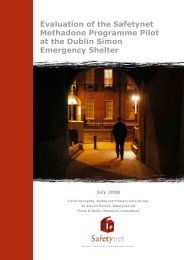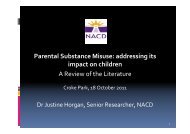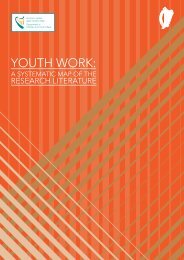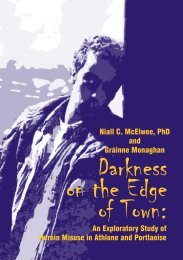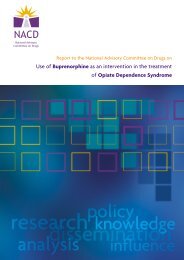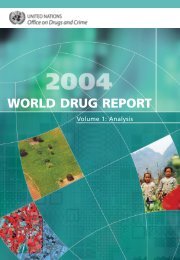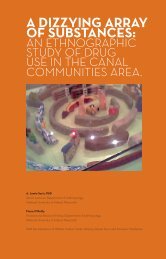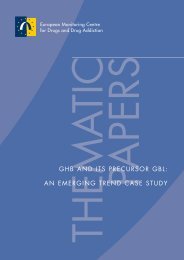Crack cocaine in the Dublin region - Health Research Board
Crack cocaine in the Dublin region - Health Research Board
Crack cocaine in the Dublin region - Health Research Board
You also want an ePaper? Increase the reach of your titles
YUMPU automatically turns print PDFs into web optimized ePapers that Google loves.
Attract<strong>in</strong>g and reta<strong>in</strong><strong>in</strong>g clientsThe Drug Treatment Agency (DTA) <strong>in</strong> <strong>the</strong> UK emphasises a number of key practiceswhich improve <strong>the</strong> success of <strong>coca<strong>in</strong>e</strong> treatment. Accord<strong>in</strong>g to <strong>the</strong> DTA, once <strong>the</strong><strong>in</strong>itial contact with a treatment service is made, rapid <strong>in</strong>take, proactive rem<strong>in</strong>ders,and practical help with attendance improve treatment uptake rates. Once <strong>coca<strong>in</strong>e</strong>users start treatment, <strong>the</strong>y tend to stay longer and respond better if <strong>the</strong>y feel that<strong>the</strong>ir concerns are be<strong>in</strong>g positively addressed and that <strong>the</strong>ir key worker is empathicand understand<strong>in</strong>g. This <strong>in</strong>dicates <strong>the</strong> crucial role that key workers play <strong>in</strong> assess<strong>in</strong>g,motivat<strong>in</strong>g and reta<strong>in</strong><strong>in</strong>g clients. The provision of complementary <strong>the</strong>rapies is importantto attract clients <strong>in</strong>to treatment, enhance <strong>the</strong>ir well-be<strong>in</strong>g and reta<strong>in</strong> <strong>the</strong>m <strong>in</strong> treatment.A similar approach to that <strong>in</strong> <strong>the</strong> UKL has been tried with <strong>in</strong>tranasal <strong>coca<strong>in</strong>e</strong> users <strong>in</strong>Tallaght and was deemed very successful.The Department of Community, Rural and Gaeltacht Affairs funded <strong>the</strong> Tallaghtcommunity-based project <strong>in</strong>volv<strong>in</strong>g St Dom<strong>in</strong>ic’s Community Response Project andKill<strong>in</strong>arden’s Community Addiction Response Programme for problematic <strong>in</strong>tranasal<strong>coca<strong>in</strong>e</strong> users (Goodbody Economic Consultants 2006). The <strong>in</strong>terventions plannedwere advertis<strong>in</strong>g service availability, project meet<strong>in</strong>gs, relationship build<strong>in</strong>g, <strong>in</strong>dividualcare plans, <strong>in</strong>dividual counsell<strong>in</strong>g, and holistic <strong>the</strong>rapies. The project commenced<strong>in</strong> February 2005. The project employed six staff members on a part-time basis. Theservice was provided through two even<strong>in</strong>g sessions and one afternoon session. The<strong>coca<strong>in</strong>e</strong> treatment service was promoted through a media campaign and proactiveoutreach work. The project communicated with <strong>coca<strong>in</strong>e</strong> users and concerned persons bytelephone and received an average of 20 calls per week. Dur<strong>in</strong>g its first year, 99 <strong>coca<strong>in</strong>e</strong>users attended <strong>the</strong> project, of whom 60 (61%) returned more than once. The uptake ofcomplementary treatments, such as acupuncture and Indian head massage, was high. Afur<strong>the</strong>r 60 people were assisted by <strong>the</strong> outreach worker. Seven clients were <strong>in</strong>terviewedat <strong>the</strong> end of <strong>the</strong> project, of whom four were abst<strong>in</strong>ent from all drugs and two said that<strong>the</strong>ir suicidal thoughts had ceased. Accord<strong>in</strong>g to <strong>the</strong> evaluators, Goodbody EconomicConsultants, <strong>the</strong> project was effective and very good value for money.Brief <strong>in</strong>terventionBernste<strong>in</strong> and colleagues (2005) conducted a randomised control trial to determ<strong>in</strong>ewhe<strong>the</strong>r brief motivational counsell<strong>in</strong>g was more effective that written <strong>in</strong>formation<strong>in</strong> reduc<strong>in</strong>g <strong>coca<strong>in</strong>e</strong> use among clients attend<strong>in</strong>g an outpatient cl<strong>in</strong>ic <strong>in</strong> Boston. Sixmonths follow<strong>in</strong>g <strong>in</strong>tervention, <strong>the</strong>y found marg<strong>in</strong>ally higher rates of abst<strong>in</strong>enceamong those who attended brief motivational counsell<strong>in</strong>g than among those whoreceived written <strong>in</strong>formation. For those report<strong>in</strong>g both <strong>coca<strong>in</strong>e</strong> and opiate use, <strong>the</strong>abst<strong>in</strong>ence rates were 22% among those who were given brief motivational counsell<strong>in</strong>g,compared to 17% among those who received <strong>in</strong>formation; among <strong>coca<strong>in</strong>e</strong> users, <strong>the</strong>correspond<strong>in</strong>g abst<strong>in</strong>ence rates were 17% and 13% respectively. It is <strong>in</strong>terest<strong>in</strong>g to<strong>Crack</strong> <strong>coca<strong>in</strong>e</strong> <strong>in</strong> <strong>the</strong> Dubl<strong>in</strong> <strong>region</strong>: an evidence base for a crack <strong>coca<strong>in</strong>e</strong> strategy127




